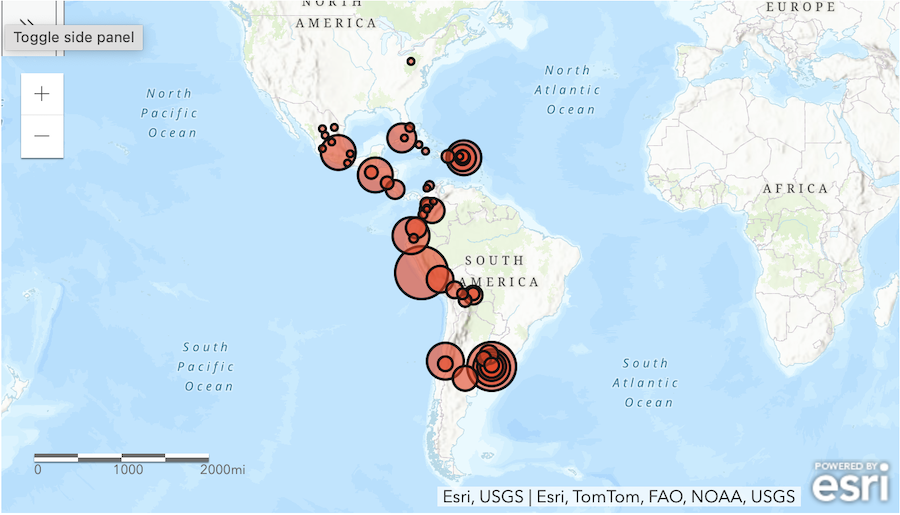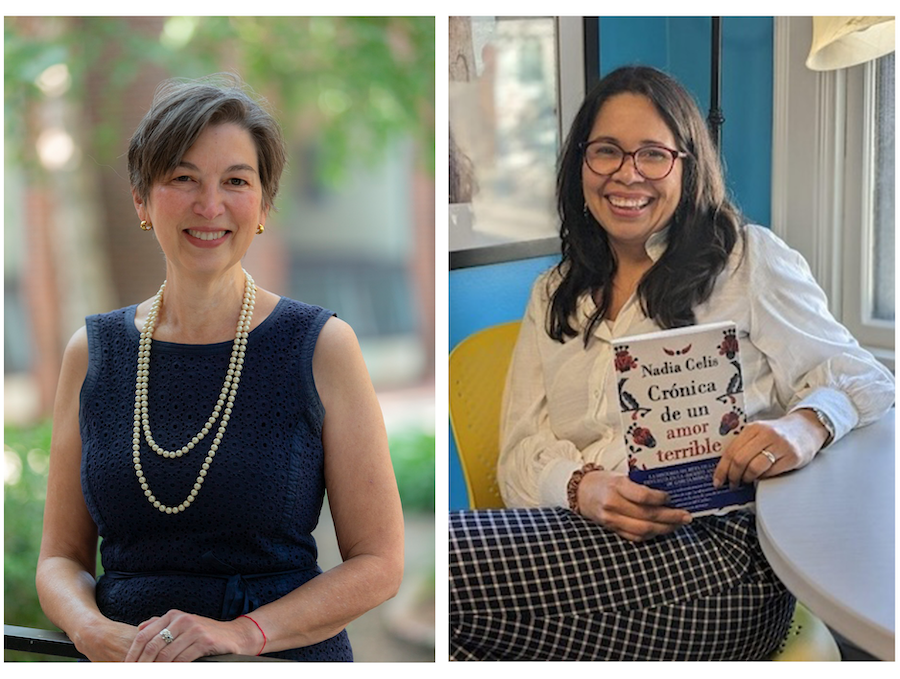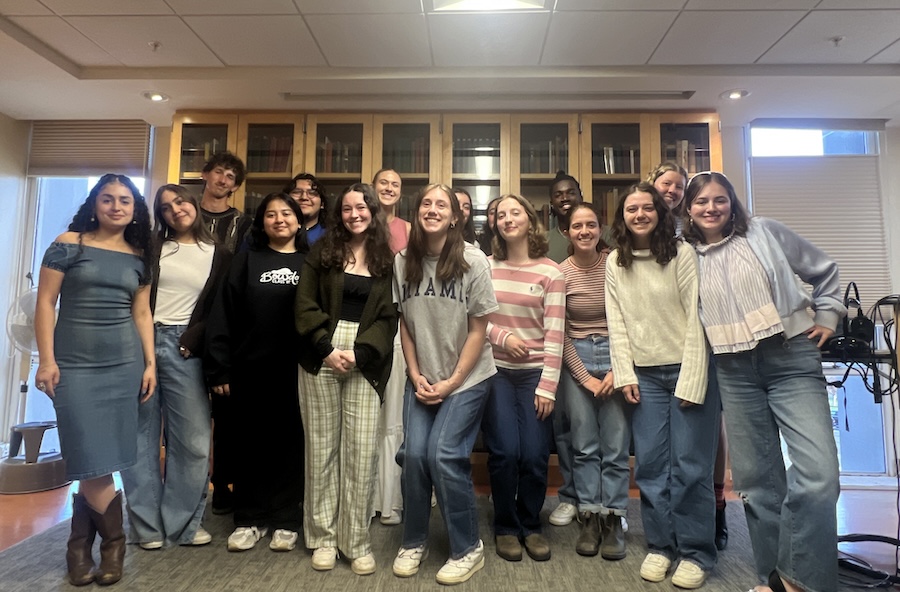Students Read Into a Booming Book Trend in Latin America
By Rebecca Goldfine
It’s the type of trend she knows well as a professor of Romance languages and literatures, and Latin American, Caribbean, and Latinx studies. Celis’s area of scholarship focuses on women writers, particularly in the Caribbean, as well as on the famous Latin American boom of the 1960s when writers such as Gabriel Garcia Márquez and Mario Vargas Llosa became household names.
“I am very well acquainted with the first boom,” she said, “this moment when Latin American literature became known internationally, when Latin America became a source of mainstream literature rather than a passive receiver of Eurocentric literature…. My interest in the previous boom, the 1960s boom, and my interest in women writers, they came together.”
She came up with a creative idea to investigate the phenomenon: she would offer a new course to include students in the project. Three years after making this decision, she taught the class, A New Boom? Latin American Twenty-First Century Women Writers, this spring. It was cross-listed with the departments of Hispanic studies and Latin American, Caribbean, and Latinx studies.
Part of the reason the class took three years to move from conception to fruition was that she needed time to collect resources—in this case, hundreds of books by Latin American women writers. She received assistance from Carmen Greenlee, Bowdoin’s humanities and media librarian.

Greenlee says the library frequently partners with faculty to acquire unique materials as they develop courses. “Our primary focus as subject librarians is to support research and offer instruction to the entire Bowdoin community,” she said. “Developing collections is an important feature of this work.”
However, Celis's wish list was a special case. She had to work harder than usual to bring “these voices here, going outside of the normal streams of book distribution” to find titles published by small presses throughout Central and South America, Greenlee said.
Celis helped the effort by touring huge book fairs in Bogotá, Mexico City, and Madrid (where she often also gave talks of her own about her popular 2023 book, Crónica de un amor terrible. La historia secreta de la novia devuelta en la muerte anunciada de García Márquez). “There’s no equivalent here—these fairs attract thousands of people,” Celis described. She met with editors, writers, readers, and publishers, especially those “working for independent presses that have been a significant source of this phenomenon.”
As she met bibliophiles on her travels, she collected their recommendations of published authors, “names that were not on my radar,” adding them to an expanding Excel sheet she shared with Greenlee.
Nadia Celis, a sought-out expert on Latin American literature, recently shared her perspective on Gabrial García Márquez in a May 22 Vanity Fair article about Netflix's adaptation of one of García Márquez most beloved novels, One Hundred Years of Solitude.
She has a sharp take on her literary hero, pointing out that one of the novel's characters is nine years old when her suitor falls for her. And the septuagenarian main character in another of García Márquez's famous books, Love in the Time of Cholera, takes a young teenager, América Vicuña, as his lover, only to abandon her soon after. She then kills herself. “When I realized that I had read and loved that book as a teenager,” Celis said, “and had not seen the abuse of América Vicuña, I sobbed.”
“One Hundred Years of Solitude is a warning about our capacity for self-destruction, particularly brought on by men,” she added. “It is a manual of patriarchy.”
So far, Greenlee said the Library has purchased more than 300 new works, mostly in Spanish, by Latin American women writers. And Greenlee says they won’t stop at this number. “I think there will be a run on a lot of these materials, because we happen to be the only holders of many of these newer works,” she said. “And we also have committed to buying more and supporting this collection going forward.”
Class Discoveries
Celis’s students split into small groups to research different nations and regions: Mexico, Central America, the Caribbean, and South American countries. They tracked circulation numbers, read and analyzed books, and in some cases, conducted interviews with authors over Zoom.
Celis asked students to find out “who are the writers, how are they publishing, did they circulate beyond their countries, did they win awards, and are they being quoted or studied by academics in journal articles?”
“We tried to figure out if there was actually a boom,” she added. All signs appear to be pointing in that direction. “This is the first time we’ve had a significant recognition of a younger generation of writers born in the ’60s and ’70s, who are writing and publishing and looking at each other to understand their current themes and obsessions.”

After collecting this kind of data*, the class launched a website filled with book-related information. “Students wrote pieces intended for a larger audience—blog posts, videos, BookToks,” Celis said, all of which will eventually be disseminated via social media with the tag @Bowdoinbooktalks. (Celis hopes other faculty will make use of the tag in the future, helping to promote a public platform for literary analysis and criticism.)
Working with a student assistant this summer—Luciana Perdomo ’26—Celis will edit the site and publish it in August. She hopes that as more people find it, it will help to promotes its fifteen featured authors, some of whom are not well known outside of their countries. “We looked at writers who aren’t that popular yet, to choose lesser-known writers who might benefit from the visibility that we will create for them,” she said.
Themes and obsessions
In mid-May, Celis invited her class to present their research in a public talk at the Hawthorne-Longfellow Library. The students discussed the authors they researched, the state of publishing across Latin America (it is flourishing in some countries, struggling in others), and the prominent themes they found in the literature they studied.
“Gender violence is a huge theme,” Celis said, as well as “the legacy of dictatorships and state violence, the deterioration of society in general by both legal and illegal forces, neoliberalism and its casualties in society—like the precariousness of living conditions and its effect on men and women—and questions of the environment.”
“It is a variety of themes, approached in many different ways,” she continued. “I wouldn’t say there is a single aesthetic element, but what is more transversal is the audacity to bend language and genre to tell stories that have not been told or to tell some stories again from different perspectives.”
“There is a lot of experimentation with genres that had been less used by women writers, such as fantasy, horror, and psychological thrillers. Myth, magic, and the supernatural are still part of the mix, but they have left magical realism far behind.”
“What I really love about these new writers is how ambitious they are being, both at the level of the themes the authors are addressing and in their use of language. They are expanding the limits of what can be done with literature. ”
—Nadia Celis, professor of Romance languages and literatures
The students at the talk—and on the website—discussed how the authors reflect on gender, collective and personal memory, and the lingering effects of state violence. Students also commented on the plethora of female viewpoints they found.
Katie Draeger ’24, who studied Chilean writers, said that the “class has been a beautiful introduction to the diversity of feminism.” She added that as a Hispanics studies major, it was the first time in four years she had dedicated herself to reading only books by women. “It was so powerful to have a thematic understanding of these works, and diving into this particular author [Alejandra Costamagna] to understand theories of violence against the body. Every other note I scribbled down was like, 'Damn, I’ve been there,' or, 'Ouch, that hurt!'”
Despite many of the writers’ clear-eyed look at gender and violence, Celis said the books don't add up to “feminist propaganda….The authors are writing about what they know, what they have experienced and what their minds are creating,” resulting in a lot of imaginative, even hyper-realist stories, she said.
However, while advancing feminist agendas is not their goal, the way the authors “strip apart patriarchy is completely unapologetic,” she continued. “Women in Latin America and beyond are still confined by the desperate attempts of patriarchy to remain in charge. These authors speak of the violent resistance of the patriarchal societies to release their hold on women’s bodies, sexualities, identities, and social presence.”
The writers she and her students read, she continued, are privileged enough to be literate and in a position to describe these difficulties, both for themselves and for women who cannot. “The testimony they are giving is very compelling. And the portrait they are collectively painting of Latin American societies is very coherent,” Celis said.
A few students said they appreciated being able to study literature from the countries they were born in or where their parents are from. “This was an amazing experience as someone from Colombia to see who are the female writers there and who is publishing them,” Luciana Perdomo ’26 said. “It was very enlightening.”
Other students talked about the experience of reading books that were challenging, painful, or distressing. “In class, we talked a lot about the new boom’s transgressions of form, about their breaking the canon and breaking conventions,” said Lily Janas ’26, who researched writers in Ecuador.
She focused on the author Mónica Ojeda, and described the uncomfortable experience of reading her novel Mandíbula, or Jawbone, after seeing a post on TikTok naming it as one of the top five most horrifying novels. “From first page to last, my jaw—my mandíbula—was on the floor,” Janas said. “It was one of the most complex, absurd, and terrifying books I’ve ever read…It was like reading 300 pages of the most intense poetry. It was like walking into a painting, the book is so evocative, you drown in the language and get encompassed in the psychological terror of being a sixteen-year-old girl.”
Carolina Bragg ’26 mentioned that she found some critical online comments made by readers about the Peruvian writer she studied, Gabriela Wiener. But Bragg rose to her defense. “I love unlikable women,” she said. “I think it is great when women are messy and they write about it and talk about things that have become complicated. I find that inspiring.”
Nadia Celis would like to thank the Committee on Teaching and Classroom Practice (CoTCP), which funded research and technology for this course, and the Bowdoin Academic Technology and Consulting team, which she said was instrumental to the course and the website. Jennifer Snow and Paul Benham experimented with AI tools that supported collaborative work; Aaron Gilbreath trained students to make graded maps and other graphics based on data; and David Israel helped with website design.